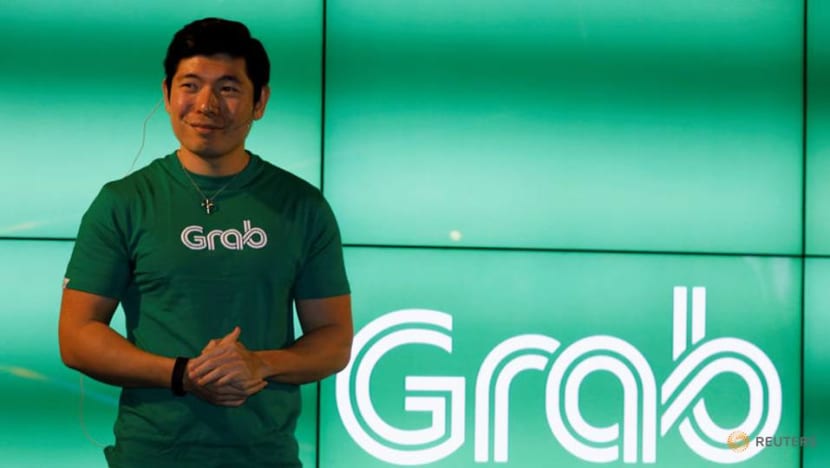commentary Commentary
Commentary: Impact of Grab-Gojek merger on consumers and drivers unlikely to be huge
Concerns over predatory, monopolistic behaviour may be overstated given how the consumer is king in the ride-hailing, food delivery and digital payments sectors, says NUS Business School’s Nitin Pangarkar.

Collage of Grab and Gojek file photos. (Photo: Reuters/Kham Beawiharta)
SINGAPORE: In early December, Grab reportedly informed its staff that it was in a position to acquire Gojek.
Grab has a strong record of growth and sports a valuation of US$15 billion. It has completed a big round of funding last year, giving it the ammunition for undertaking a large acquisition.
The talk has fuelled discussion about the possible impact of the merger on key stakeholders such as consumers and drivers, partly because both companies are associated with ride-sharing in consumers’ minds.
READ: Gojek in talks with Tokopedia for US$18b merger - report
READ: Indonesian Grab, Gojek drivers threaten nationwide protests over merger talks
Memories of Grab’s acquisition of Uber’s Southeast Asian operations just over two years ago are still fresh.
Both Grab and Uber incurred fines from the Competition and Consumer Commission of Singapore (CCCS) and Philippine authorities for their merger. Some observers noted that after the merger, Grab’s customers paid more while its drivers faced less favourable terms.
A BIG MOTIVATION FOR BOTH COMPANIES
The two companies may be considering the merger because of several key factors.
First, they have complementary strengths with Grab having strong positions in ride-hailing and food delivery markets, especially in Singapore, and Gojek enjoying a strong position in Indonesia with a valuation of about US$10 billion.
The companies have also fought intensely with each other, and other rivals, to gain strong market share in their respective markets.

But as they mature, investors, such as Softbank which is backing Grab, may be pushing Grab and Gojek to move away from aggressive marketing and price wars towards a consolidation of market position in pursuing the ultimate goal of profitability.
Having raised large sums of capital over the last several years, the companies may also need to turn to public, rather than private, markets to fund their future growth ambitions. Any public listing would be helped by positive profits.
And Grab is scheduled to pay Uber US$2.26 billion (S$3 billion) if it fails to achieve an initial public offering by March 2023.
Gaming and e-commerce Singapore-based giant Sea’s incredible rise may have also injected some urgency into the move.
READ: Commentary: Singapore's Sea is world's best performing stock. And it can do better
READ: Commentary: Is trouble brewing in Grab paradise?
CONCERNS BY REGULATORS
One view holds that because both compete in markets with already very few big players, some competition watchdogs, such as the CCCS, may oppose the merger because of concerns that the terms for drivers and consumers may worsen, post-merger.
There are some caveats to this train of thought, however.
The ride-hailing industry is on a stronger footing since the Point-to-Point Transport Industry Act was passed in 2019, with restrictions on exclusive contracts and clarity on fares ensuring contestability and transparency.
READ: Commentary: Grab’s new platform fee may have raised eyebrows but it is nothing out of the ordinary
Separately, Indonesian law requires that the competition authority KPPU be notified about mergers within 30 days, but it does not allow KPPU to prevent the merger.
Hence, even if the merger faces some resistance from antitrust authorities in Singapore, it is unlikely to be legally obstructed in Indonesia, a key market for Gojek as well as the merged entities.

Another view suggests there will still be competition in the market even with a merger. This is because a company can be dominant in one industry and country while weak in the others.
While Grab has a large market share in the ride-hailing and food delivery industries in Singapore, Gojek has a much smaller share in ride-hailing and a limited pie in food delivery.
Even if the merger happens, consumers still have other options in ride- hailing and food delivery: foodpanda, deliveroo and Ryde to name a few.
In my assessment, however, the merger has many hurdles to clear. Apart from having to assure regulators the merger is not inimical to the public interest, investors in the two companies have to agree on the merger terms, which will require wrangling given that most have a tendency to overestimate the value of their stakes in companies.
READ: Commentary: Ant had such big ambitions. Then China authorities stepped in
READ: Commentary: If we can share or hitch rides, why not food delivery?
Of concern also might be how much say Grab CEO Anthony Tan has over the direction and decisions of the merged entity.
ALTERNATIVE AVENUES FOR GROWTH
I would not be alarmed about the impact of the merger on consumers, drivers and deliverers just yet. Observers tend to focus too much attention on the ride-hailing market and potential weakening of competition in that market.
While both Grab and Gojek started out as ride-haling companies, their priorities are likely to be on other sectors, especially digital payments and food delivery, going forward.
The ride-hailing market has become less attractive, especially in Singapore, with the pandemic and work-from-home trend. Consumer demand will play a bigger role in any price increase in the ride-hailing market, given that consumers can find substitutes.
Drivers are one group of stakeholders that may be at risk if the merger happens, though how they will be affected is not clear at this point in time.

After the initial period when ride-hailing companies aggressively signed up as many drivers as possible, the terms of drivers have been gradually altered, particularly after COVID-19 hit Singapore. I expect that to continue as the market matures.
Food delivery has meanwhile grown tremendously and is already a more important contributor to Grab’s revenues than ride- hailing.
READ: Commentary: Isn’t Grab’s cash advance scheme a loan programme?
With a good proportion of unbanked or underbanked population in several countries in the region, as well as a big chunk of payments in the region taking place in cash, growth prospects for Grab’s payments business are indeed strong.
To build its position in this sector, Grab has also recently obtained a license for operating a digital bank in partnership with Singtel.
For now, merger remains nothing more than a possibility. Grab stands to benefit most from such a move, with a potential listing as Singapore’s first unicorn.
An important question might be where the tech giant might list.
Nitin Pangarkar is Associate Professor in the Department of Strategy and Policy at the National University of Singapore Business School. The opinions expressed are those of the writer and do not represent the views and opinions of NUS.
How much credit does F&B in Singapore deserve for getting through COVID-19 thus far? Listen to CEO foodpanda Jakob Angele and Managing Director of The Soup Spoon Andrew Chan give their take on CNA's Heart of the Matter podcast:















